Abstract
The coaggregation properties of recent human oral streptococcal and actinomyces isolates from the same site were determined and compared with the coaggregation properties of well-characterized stock strains of these two kinds of bacteria. Streptococcus sanguis, Actinomyces viscosus, Actinomyces naeslundii, and phenotypically similar strains of actinomyces were isolated from subgingival samples from periodontally healthy older individuals, from persons participating in an experimental gingivitis study, and from young persons with localized (juvenile) and generalized (severe) periodontitis. All 34 of the actinomyces isolates coaggregated with reagent strains of S. sanguis that represented the four streptococcal coaggregation groups. Most of these actinomyces exhibited coaggregations identical to those of actinomyces stock strains. However, five isolates of an Actinomyces WVa-963 serovar exhibited a coaggregation pattern different from any previously described, which was used to define coaggregation group F. All coaggregations with members of this group were lactose inhibitable. Only 57% (8 of 14) of the recent S. sanguis isolates coaggregated with actinomyces reagent strains. But when the nonreactive streptococcal isolates were tested for their ability to coaggregate with actinomyces from the same patient, a new, highly specific coaggregation pattern (group 6) for S. sanguis was discovered. Coaggregation of these streptococci was observed only with certain isolates of A. naeslundii (members of coaggregation group D) from the same site, and none of these coaggregations were inhibited by lactose. Subsequent testing revealed that streptococci of group 6 coaggregated with group D actinomyces from other sources but not with actinomyces of other coaggregation groups. Only two strains of S. sanguis failed to coaggregate with any strain of actinomyces tested. These results indicate that nearly all fresh isolates of these species obtained from both diseased and healthy sites exhibit specific, nonrandom patterns of coaggregation and suggest the widespread occurrence of in vivo cell-to-cell recognition between oral actinomyces and streptococci.
Full text
PDF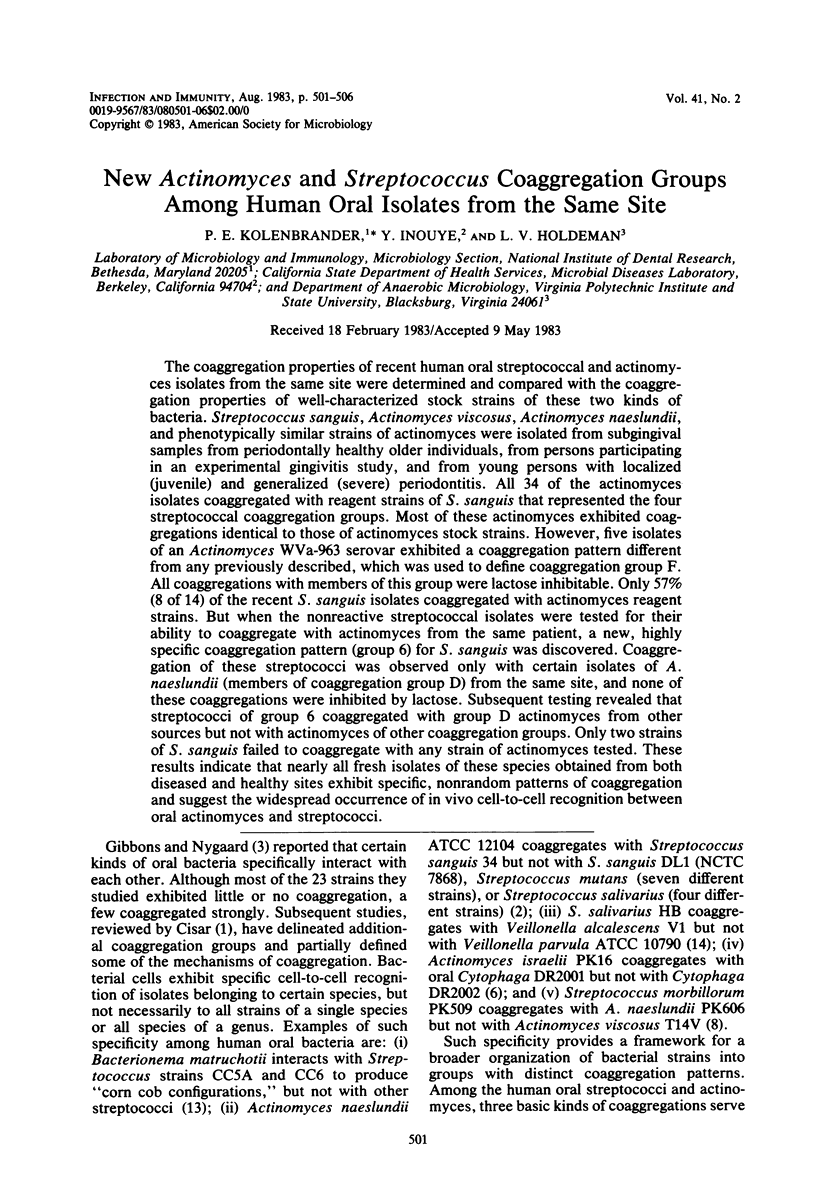
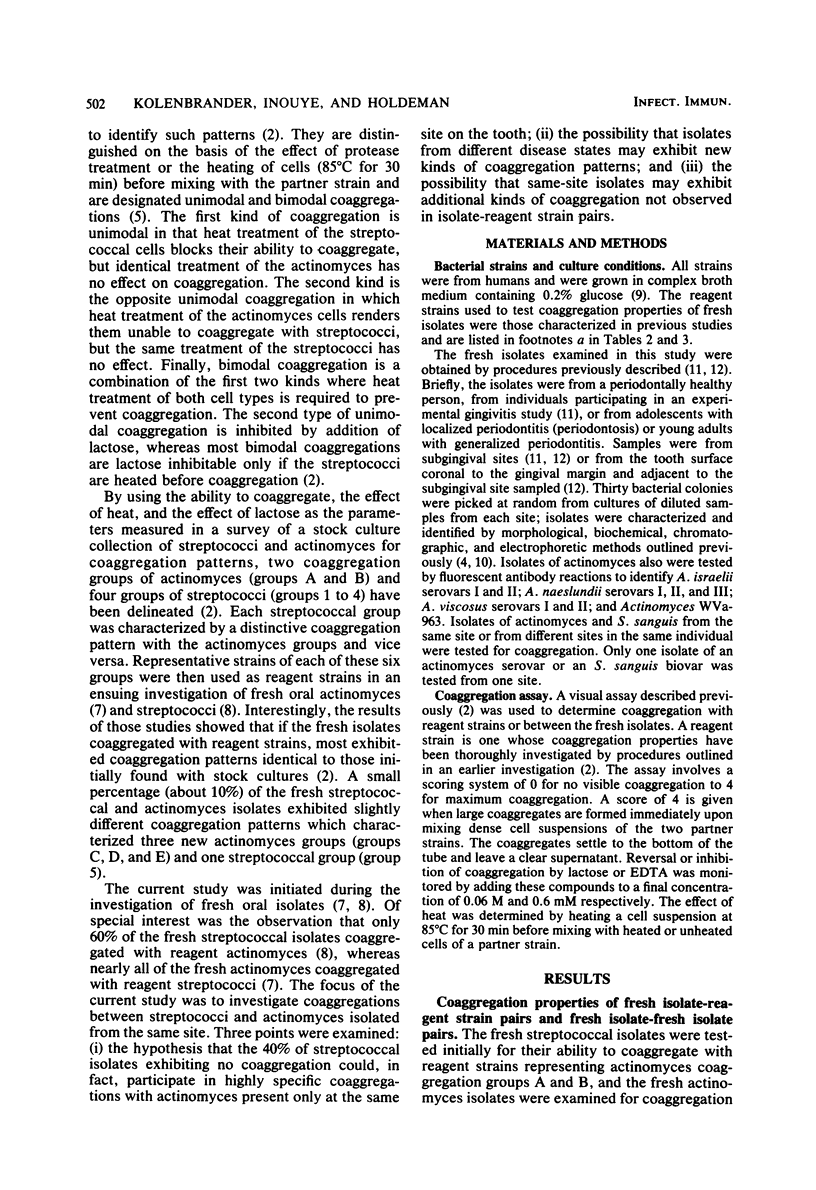
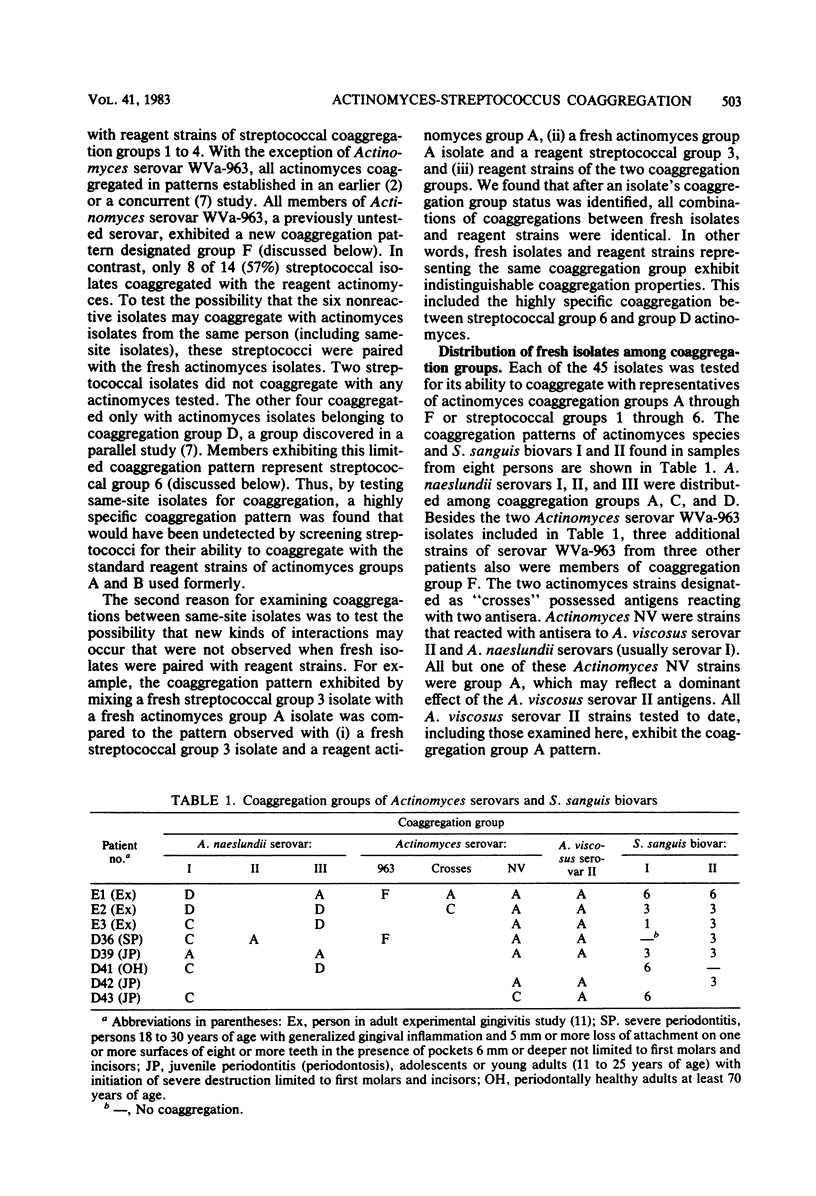
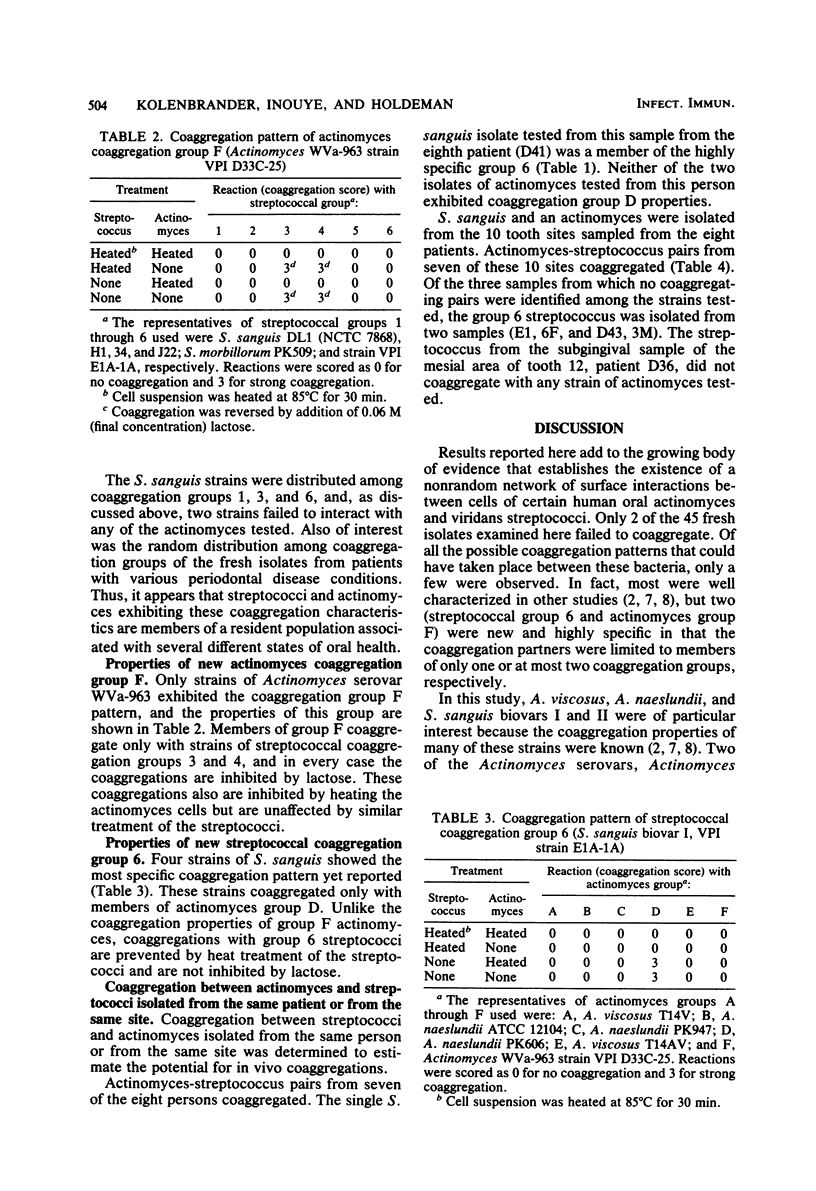

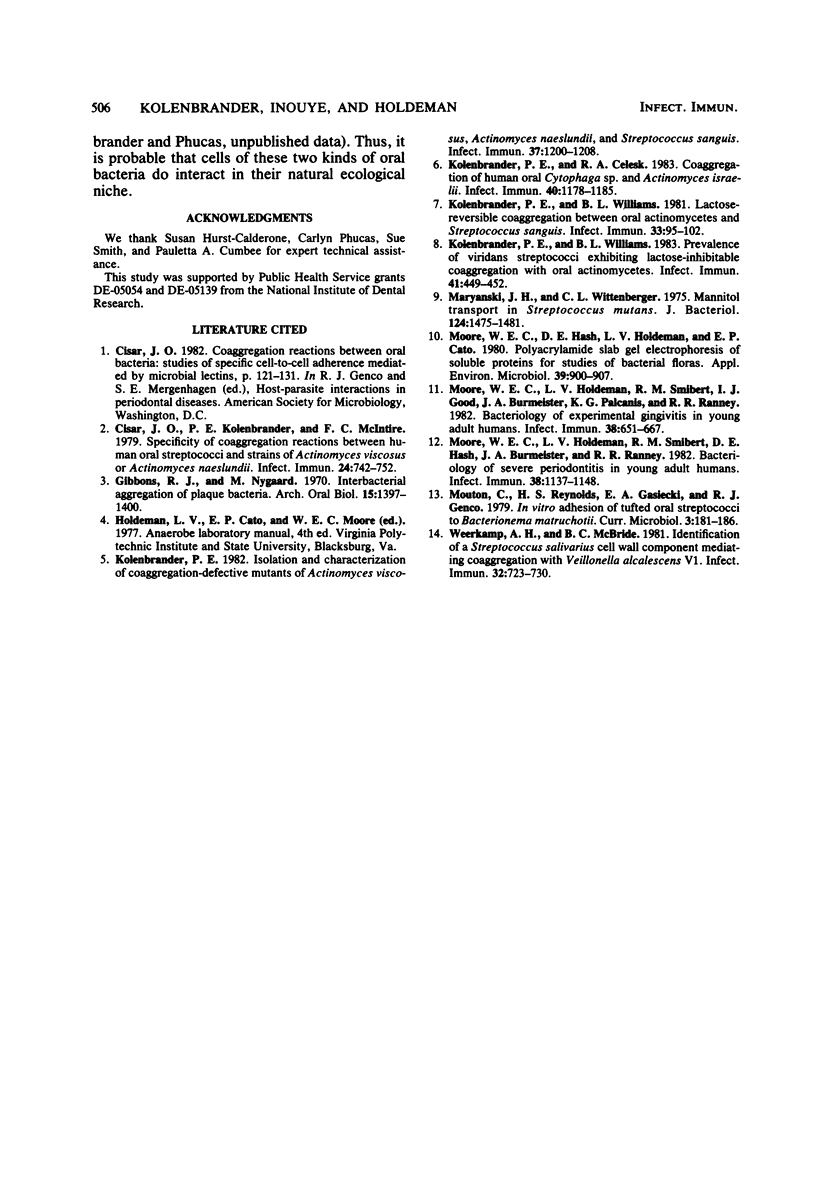
Selected References
These references are in PubMed. This may not be the complete list of references from this article.
- Cisar J. O., Kolenbrander P. E., McIntire F. C. Specificity of coaggregation reactions between human oral streptococci and strains of Actinomyces viscosus or Actinomyces naeslundii. Infect Immun. 1979 Jun;24(3):742–752. doi: 10.1128/iai.24.3.742-752.1979. [DOI] [PMC free article] [PubMed] [Google Scholar]
- Gibbons R. J., Nygaard M. Interbacterial aggregation of plaque bacteria. Arch Oral Biol. 1970 Dec;15(12):1397–1400. doi: 10.1016/0003-9969(70)90031-2. [DOI] [PubMed] [Google Scholar]
- Kolenbrander P. E., Celesk R. A. Coaggregation of human oral Cytophaga species and Actinomyces israelii. Infect Immun. 1983 Jun;40(3):1178–1185. doi: 10.1128/iai.40.3.1178-1185.1983. [DOI] [PMC free article] [PubMed] [Google Scholar]
- Kolenbrander P. E. Isolation and characterization of coaggregation-defective mutants of Actinomyces viscosus, Actinomyces naeslundii, and Streptococcus sanguis. Infect Immun. 1982 Sep;37(3):1200–1208. doi: 10.1128/iai.37.3.1200-1208.1982. [DOI] [PMC free article] [PubMed] [Google Scholar]
- Kolenbrander P. E., Williams B. L. Lactose-reversible coaggregation between oral actinomycetes and Streptococcus sanguis. Infect Immun. 1981 Jul;33(1):95–102. doi: 10.1128/iai.33.1.95-102.1981. [DOI] [PMC free article] [PubMed] [Google Scholar]
- Kolenbrander P. E., Williams B. L. Prevalence of viridans streptococci exhibiting lactose-inhibitable coaggregation with oral actinomycetes. Infect Immun. 1983 Aug;41(2):449–452. doi: 10.1128/iai.41.2.449-452.1983. [DOI] [PMC free article] [PubMed] [Google Scholar]
- Maryanski J. H., Wittenberger C. L. Mannitol transport in Streptococcus mutans. J Bacteriol. 1975 Dec;124(3):1475–1481. doi: 10.1128/jb.124.3.1475-1481.1975. [DOI] [PMC free article] [PubMed] [Google Scholar]
- Moore W. E., Hash D. E., Holdeman L. V., Cato E. P. Polyacrylamide slab gel electrophoresis of soluble proteins for studies of bacterial floras. Appl Environ Microbiol. 1980 Apr;39(4):900–907. doi: 10.1128/aem.39.4.900-907.1980. [DOI] [PMC free article] [PubMed] [Google Scholar]
- Moore W. E., Holdeman L. V., Smibert R. M., Good I. J., Burmeister J. A., Palcanis K. G., Ranney R. R. Bacteriology of experimental gingivitis in young adult humans. Infect Immun. 1982 Nov;38(2):651–667. doi: 10.1128/iai.38.2.651-667.1982. [DOI] [PMC free article] [PubMed] [Google Scholar]
- Moore W. E., Holdeman L. V., Smibert R. M., Hash D. E., Burmeister J. A., Ranney R. R. Bacteriology of severe periodontitis in young adult humans. Infect Immun. 1982 Dec;38(3):1137–1148. doi: 10.1128/iai.38.3.1137-1148.1982. [DOI] [PMC free article] [PubMed] [Google Scholar]
- Weerkamp A. H., McBride B. C. Identification of a Streptococcus salivarius cell wall component mediating coaggregation with Veillonella alcalescens V1. Infect Immun. 1981 May;32(2):723–730. doi: 10.1128/iai.32.2.723-730.1981. [DOI] [PMC free article] [PubMed] [Google Scholar]


